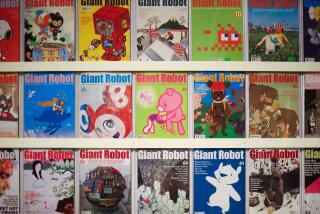Tiny Hands Across the Water
- Share via
A regal reunion of aging cultural ambassadors gathered at the Japanese American National Museum turns poignant as their stories are revealed. One Japanese immigrant was rescued from a basement. Another, clad in an elegant jade kimono, was put on public display in her adopted country and forced to face the wall.
The 75-year-old emissaries standing at attention in the chilly exhibition hall are remnants of an earlier era, when the children of the United States and Japan reached across an ocean by exchanging potent symbols of childhood.
These littlest diplomats are dolls.
In 1927, American schoolchildren sent more than 12,700 dolls to Japan as part of a grass-roots friendship gesture set in motion by Sidney L. Gulick, a U.S. missionary who lived in Japan for 25 years. In return, Japanese schoolchildren donated the equivalent of about a half-penny apiece to pay for the oversized Japanese dolls that were shipped to this country. A total of 58 were sent--one for each of Japan’s prefectures, major cities and pre-World War II colonies. The dolls toured America before landing in museums in 46 states.
This gathering of seven of the “blue-eyed dolls” and the five stately torei ningya, or “return dolls,” is the first time the dolls have been brought together “in a large way on the West Coast,” says Lisa Itagaki, co-curator of the exhibition called “Passports to Friendship.”
“This exchange is about legacy, what one man instigated and how his educational objectives can apply now,” she says. “It’s very post-9/11. People are very suspicious of people of other cultures. Instead of being suspicious, let’s initiate an exchange, let’s get to know someone else.”
The first step toward understanding comes just inside the door. Children can pick up a four-page museum “passport” that they fill out with personal information, including country of citizenship, before stamping it at point of entry.
“Coming here may be the first time children look outside of their neighborhoods and think of themselves as American citizens or Japanese citizens,” Itagaki says. “It may expand their thinking and help them become global members.”
The first of two exhibition rooms is spartan yet palatial, with the nearly 3-foot-high Japanese dolls standing sentry, resplendent in their finest threads. The dolls possess beauty pageant names like Miss Toyama or Miss Kagawa (who was made to face the wall during wartime with Japan), and look like potential winners. As they should. At up to $50,000 a doll, the cost of their restoration could rival a plastic surgeon’s bill.
The American “blue-eyed dolls” are far from showpieces. They have less refined names, such as Helen and Erica, and have sensible, worn clothing. Almost every elementary school in Japan received one of the “friendship dolls” from America, says Nancy Araki, the museum’s director of community affairs.
“During wartime, the dolls were put into storage or destroyed. A wonderful discovery has been the 300 dolls or so that have emerged in Japan and the stories that go with it. Teachers, principals, or whoever, defied the Japanese military orders to destroy them,” she says.
My 11-year-old son, who informs me on the trip downtown that “a doll museum is not exactly my cup of tea,” and I find ourselves captivated by the same thing, sets of miniature royal dolls in historically correct costumes that are displayed every March 3 in honor of Girl’s Day in Japan.
One especially moving set of miniature dolls was dressed in clothes knitted by a Japanese American mother incarcerated during the war. She was not allowed to bring doll clothes with her yet wanted to share the cultural tradition with her daughter.
The interactive activities skew young--there are doll suitcases that can be packed for a trip, postcards with the outline of a doll to be colored in, and a tidy area where children can cull through boxes and documents as they pretend to be museum researchers.
My 14-year-old daughter eyes Maria, a doll that will be sent to Japan as a thank-you and that looks suspiciously like one of her dolls that has been packed off to our garage. “When I was 7 and really into American Girl dolls,” she says, “this would have been so cool.”
“Passports to Friendship” at the Japanese American National Museum, 369 E. 1st St., Los Angeles. Tuesdays-Sundays, 10 a.m.-5 p.m., till 8 p.m. on Thursdays. $6; $3, ages 6-17; 5 and younger, free. Free admission the third Thursday of the month and Thursdays from 5 to 8 p.m. (213) 625-0414 or www.janm.org.
More to Read
The biggest entertainment stories
Get our big stories about Hollywood, film, television, music, arts, culture and more right in your inbox as soon as they publish.
You may occasionally receive promotional content from the Los Angeles Times.











